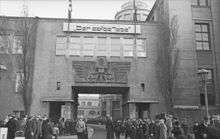The Eternal Jew (art exhibition)


The Eternal Jew (Der ewige Jude) was the title of an exhibition of degenerate art (entartete Kunst) displayed at the Library of the German Museum in Munich from 8 November 1937 to 31 January 1938. The exhibition attracted 412,300 visitors, over 5,000 per day.[1]
After the exhibition ended in Munich, it was displayed in Vienna from 2 August until 23 October 1938 and subsequently in Berlin from 12 November 1938 until 31 January 1939.[1]
Degenerate art
Although this was one of the most famous Nazi-sponsored exhibition of degenerate art, it was preceded by a number of other exhibitions in cities such as Mannheim, Karlsruhe, Dresden, Munich, Berlin and Vienna.[2] The works of art displayed at these exhibitions generally consisted of works executed by avant-garde artists, especially expressionist German artists such as Max Beckmann, Ernst Kirchner and Emil Nolde, who had become recognized and esteemed in the 1920s. The objective of the exhibition was not to hold these works up as exemplary and admirable but to present them as worthy of condemnation and derision.[2] The large numbers of attendees may indicate that the art shown was actually more popular than the Nazis supposed, although entrance was free, another attraction to the public.
Attendance of over two million visitors was recorded.[2]
References
| Wikimedia Commons has media related to Eternal Jew (Nazi exhibition). |
- 1 2 "Der ewige Jude - "The Eternal Jew or The Wandering Jew"". Retrieved 2011-11-14.
- 1 2 3 West, Shearer (2000). The visual arts in Germany 1890-1937: Utopia and despair. Manchester University Press. p. 189. ISBN 978-0-7190-5279-8. Retrieved 14 November 2011.